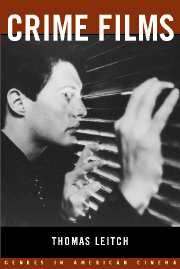Book contents
- Frontmatter
- Contents
- List of Illustrations
- Acknowledgments
- 1 The Problem of the Crime Film
- 2 Historical and Cultural Overview
- 3 Critical Overview
- 4 Fury and the Victim Film
- 5 The Godfather and the Gangster Film
- 6 Double Indemnity and the Film Noir
- 7 Basic Instinct and the Erotic Thriller
- 8 Murder on the Orient Express, Blue Velvet, and the Unofficial-Detective Film
- 9 Chinatown and the Private-Eye Film
- 10 Bullitt and the Police Film
- 11 Reversal of Fortune and the Lawyer Film
- 12 Fargo and the Crime Comedy
- 13 Conclusion: What Good Are Crime Films?
- Notes
- Selected Bibliography
- Filmography/Videography
- Index
1 - The Problem of the Crime Film
Published online by Cambridge University Press: 27 October 2009
- Frontmatter
- Contents
- List of Illustrations
- Acknowledgments
- 1 The Problem of the Crime Film
- 2 Historical and Cultural Overview
- 3 Critical Overview
- 4 Fury and the Victim Film
- 5 The Godfather and the Gangster Film
- 6 Double Indemnity and the Film Noir
- 7 Basic Instinct and the Erotic Thriller
- 8 Murder on the Orient Express, Blue Velvet, and the Unofficial-Detective Film
- 9 Chinatown and the Private-Eye Film
- 10 Bullitt and the Police Film
- 11 Reversal of Fortune and the Lawyer Film
- 12 Fargo and the Crime Comedy
- 13 Conclusion: What Good Are Crime Films?
- Notes
- Selected Bibliography
- Filmography/Videography
- Index
Summary
The crime film is the most enduringly popular of all Hollywood genres, the only kind of film that has never once been out of fashion since the dawn of the sound era seventy years ago. It is therefore surprising to discover that, at least as far as academic criticism is concerned, no such genre exists. Carlos Clarens's magisterial study Crime Movies (1980) begins by criticizing Robert Warshow's seminal essay “The Gangster as Tragic Hero” (1948) for its narrow definition of the gangster film, based on liberal social assumptions that “limited genres to one dimension apiece.” Yet Clarens's definition of the crime film is equally delimited by its pointed exclusion of “psychological thriller[s]” like Shadow of a Doubt (1943), Laura (1944), and Kiss Me Deadly (1955) from its purview on the grounds that their characters are insufficiently emblematic of “the Criminal, the Law, and Society.”. Larry Langman and Daniel Finn place themselves outside the debate over whether or not crime films include psychological thrillers by announcing in the Preface to their encyclopedic reference, A Guide to American Crime Films of the Forties and Fifties: “The American crime film does not belong to any genre. … Instead, it embodies many genres.” But their attempt to rise above the problem of classification merely indicates how deeply entrenched that problem is.
- Type
- Chapter
- Information
- Crime Films , pp. 1 - 17Publisher: Cambridge University PressPrint publication year: 2002



